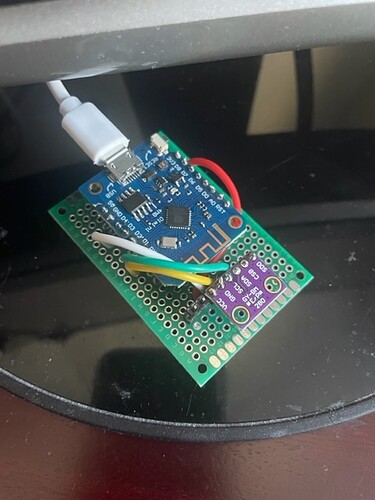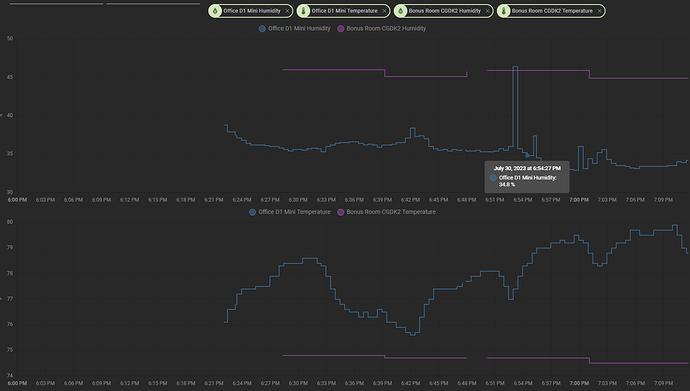@flega. Hello I read yours fully. I am now not sure what reply you need. I think you are telling me it is broken. If you are not sure open both doors and calibrate to one level. Or move your SHT31 into your other greenhouse and test both in the same place. Most of those cheap units don’t survive external environment
The DHT sensors are not rated for outdoor use.
@tom_l I have seen some greenhouses which are professionally ventilated and heated. I suspect the humidity might be comparable to my shower room. Otherwise my own greenhouse, has extreme heat warm up and cool down, so the dew point will at some point be occurring on the sensor; it will be dripping wet.
Didn’t know that. I use them in enclosure and everything was fine until low temp&high humidity (probably condensation on sensing part). But sensor with built-in heater is not having this kind of problem, so I recommend them.
I have a similar problem, that my BME280 always gives ~10% to low humidity:
Dark blue is a Netatmo station and light blue is a Tado thermostat, which I would say both have good sensors.
For the temperature the values are always quite similar, so I wanted to know, if I somehow can correct this? My easiest fix would be to create a new sensor, that has a +10 offset over the value I get from the bm280?
Or is there a similar cheap sensor as the bme280 out there, that is compatible with esphome?
It seems that your current BME shows steadily 10% too low. In this case solution is easy - just add offset to esphome and you’re done. That’s what i do with my cheap chinese sensors - i calibrate them with known accurate result.
There are other sensors supported (check esphome’s entry site), but main thing is that they are bought originals from trusted seller. Aliexpres etc…ones are not always fakes, but they are usually “drop-outs” - product which didn’t pass final tests - that’s why they are cheap and that’s why they can show correct, or they can be quite off. At the end you must buy 5 of them to get one which is accurate, but in this case you’re at the price of genuine one which will always show correct values.
I am in the process of looking into a temp/hum sensor for greenhouses in which accuracy is quite important to get a realistic overview on temp/hum development in the greenhouse.
I came across this youtube, in which a lot of off the shelve display sensors are tested and also some DIY sensors hooked up to an ESP32.
The approach of testing the sensors in this video is quite good I think, however the problem is that he uses only one sensor of each type. His experience with the BME280 is very good and with the DHT is bad. If I read the messages in this forum topic, it does go along with the varying experiences people have with both sensors. Apparently both sensors are being reported as bad and good.
In the greenhouse I might just go with BME280 at first and add a non-smart analog sensor to take samples a couple of times a week and compare them to the digital reading.
Or maybe I just try it with certain reference points, I know there is method with salt in which there is known physical value of the humidity. Will have to look into that. https://www.vernier.com/til/4337
I’ve had three BME280 chips — authentic ones. They were all crap and suffered from self-heating. I haven’t had issues with a DHT22 yet.
There are actually interesting scientific papers available of research done on several low cost sensors that are used with microcontrollers.
If you do a search on Google Scholar, some research results will pop up:
For instance:
https://scholar.google.com/scholar?q=bme280+dht+temperature+sensor
This lead me to, among others:
This is an interesting paper going over all kinds of properties of a sensor.
For instance the graph on ‘Rise time’ was interesting. Apparently they experienced the BME280 to respond very slow to the actual temperature when the temperature rises quickly. Something that is important to take in account when using in a Greenhouse, like me, where temperature can rise quite quickly.

That’s also the DHT11 (not a DHT22), which quite frankly is a shit sensor.
Having said that, neither of the DHTs are rated for outdoor use.
Interesting…
do you know if BME280/380 are also indoor use only? I have a couple od those out for over a year now, and they still work (that’s 1xBME280, 1xBME380 and 1xDHT3x). If they are not to be out, i’ll have to look for alternative… (maybe any suggestion?)
The BME280 datsheet lists weather stations as an application example, so it does appear to be outdoor rated. Assuming you take the proper precautions. Conformal coating of PCBs, protection from dripping water, etc…
Aha…thanks, that’s great then. My sensors are in Stevenson’s screens and i coated back of pcb’s with colophonium solution, so i guess they should be fine…
The reason for three sensors is because that way i can guarantee that at least one of them is always in a shade, so HA shows correct (lowest of three) temperature. Yeah, i know, i should build proper wooden weather house and put it in there… but i just don’t have a place to put such big thing …
Purchase one of these lovely whatchamacallits from AliExpress?
Just under $6 USD
Plastic outer shield for thermo hygro sensor, spare part for weather station
https://www.aliexpress.us/item/2251832313632619.html
I made these housings myself - from plant pots bottoms (the part which comes under the pot, don’t know the wor for it, sorry) . A bit of CNC milling, a bit of 3D printing, some stainless steel screw rods and you’re done…
Well, I stumbled on this thread after finally building some D1 Mini’s + BME280’s and an ESP32 + BME280’s.
I ended up making 3 of these because… The first one was to see if I could create it. The second one was my first “production” build. And the third one was my real production build.
Long story short, the closer the BME280 is to the chip in question, the more inaccurate the temperature output is, or ESP8266 transforms the data differently than an ESP32.
Build 1
ESP8266 & BME280. The sensor is about an inch away from the controller and separated by a housing. The numbers aren’t far off, but they aren’t necessarily close.
Build 2
ESP8266 & BME280. The sensor is about a 1/2 inch away from the controller and separated by a housing. This was my first production build. I put it in a housing in the basement. This is when I thought these BME sensors were bad because this was reading 10 degree’s higher than the BLE temperature sensor and the humidity was 30% low. I quickly moved this device to my office (same as the bonus room). Unfortunately, I didn’t collect data when the readings were wildly off, only after I moved it. It now reads a bit high without the case, but it’s much closer to the cheap BLE sensors.
Build 3
ESP32 & BME280. I built this with the ESP32 to enable Bluetooth proxies so I could compare values to the cheap BLE sensor.
The is sensor is about 6 inches away from the controller. Both the cheap BLE sensor and the BME280 agree on humidity (±5%) and temperature (±0.5 ºF). The humidity is low however the temperature is spot on. I’ll probably just adjust the humidity by 5% because my humidifier agrees with the BLE sensor.








